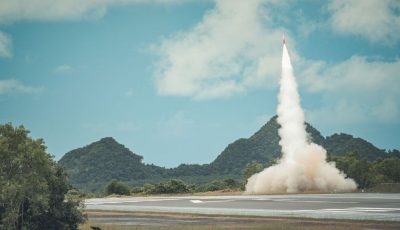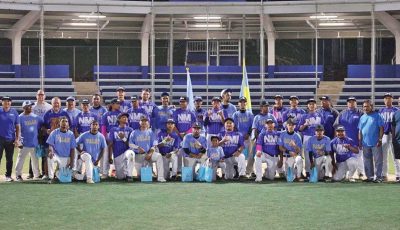Telltale signs: Temperatures rising in the Shoal
Occupying the full top of the front page of the Philippine Daily Inquirer on June 19 was a color photo of one Chinese soldier raising the red flag of China and another holding a survey rod on the Scarborough Shoal. The news article that accompanied the photo (“China ships stay in Panatag Shoal”) reported that “Beijing had not expressed any intention of withdrawing its service ships from Scarborough Shoal.”
The day before, President Benigno S. Aquino III had announced that the two Philippine Navy vessels stationed in the Shoal-in a standoff with 92 Chinese vessels there since April 10-were being recalled back to port “consistent with our agreement with the Chinese government on the withdrawal of all vessels from the shoal’s lagoon to defuse tensions” in the area.”
After the Philippine ships left, China’s ships stayed and occupied the Shoal as the Inquirer front-page photo appeared to confirm.
The Philippines had been snookered by China once again as occurred in 1994 when Philippine Navy ships left the Panganiban Reef-otherwise known as Mischief Reef-because of a typhoon, only to return after the monsoon to find China’s Navy occupying the reef-only 87 miles from Palawan and almost 600 miles from China. China has since constructed a concrete fortress on Mischief Reef.
After the Inquirer published its news online, an emergency national telephone conference was called by members of US Pinoys for Good Governance-the group that sponsored the May 11 global protests against China’s intrusion in the Scarborough Shoal-to discuss the implications of this new escalation of the conflict.
What the group members feared had materialized, China had occupied the Shoal.
In the course of the two-hour-long telephone conference, frantic calls were made to Philippine Department of Foreign Affairs officials to verify whether China had actually seized control of the Shoal. But no verification was obtained before the conference call meeting ended so another conference call was set for the next night if the Chinese occupation of the Shoal was confirmed.
The next day, Philippine Defense Secretary Voltaire Gazmin warned that if China did not withdraw its ships from the Shoal, then he would order the return of Philippine Navy ships.
The return of the Philippine Navy raised the specter of an incident in 1988 when Vietnamese navy sailors sought to restore the flag of Vietnam on Johnson Reef in the Paracel Islands off Vietnam. When the Chinese flag was removed, the Chinese Navy fired on the unarmed Vietnamese sailors and massacred 77 of them. Video footage of the massacre was filmed by the Chinese Navy and broadcast in China to show the resolve of the mighty Chinese People’s Liberation Navy.
Could this bloody Vietnam scenario be repeated in the Scarborough Shoal?
Not according to Max Boot. In his June 24, 2012 article which appeared in the Wall Street Journal titled “China Starts to Claim the Seas” where Boot asserts that “in fact China is the classic bully with a glass jaw.”
Boot cites the example of the tiny Pacific nation of Palau with a population of just 20,000. “In late March, at virtually the same time that the Scarborough Shoal standoff was beginning,” Boot writes, “a Chinese fishing vessel illegally entered Palau’s waters. When the poachers ignored repeated demands that they leave an area designated as a shark sanctuary, police from Palau’s Fish and Wildlife Division opened fire, trying to sink the offending vessel.”
“The result: one fisherman dead and 25 captured. A couple of weeks later, under the terms of a deal with China, the poachers were fined $1,000 each and flown back home. The Chinese must have been furious, but their diplomat on the scene had nothing to say except “it is a good outcome.”
As speculation mounted about whether China would react as it did in Vietnam in 1988 or as it did in Palau in April of 2012, news came from DFA officials that the photo used on the front page of the Inquirer was a 10-year-old photo that was posted on the China Embassy website. China has not physically occupied the Shoal and planted its flag there, at least not yet.
On June 22, members of the US Pinoys for Good Governance joined members of the US Vietnamese community in mounting a demonstration in front of the United Nations building in New York to protest China’s “creeping invasion” of the Philippines and Vietnam. Leaders of the two communities announced that they were launching a nationwide boycott of China-made products.
According to Eric Lachica, “if even one million, out of the four million Filipinos in the U.S., stop buying Chinese products or goods, we will create a huge financial penalty on China.”
While an economic boycott of China directed at Walmart stores was being launched in the U.S., the Philippine Daily Inquirer reported on June 25 that “a Chinese vessel last week rammed a Philippine fishing boat north of the disputed Scarborough Shoal in the West Philippine Sea (South China Sea), killing a Filipino fisherman and leaving four others missing.”
The article reported that the ramming of the Philippine boat causing the death of Bolinao fisherman Christopher Carbonel “may have been the first casualty in the dispute between China and the Philippines over Scarborough Shoal.” Two days earlier, the state-owned China News Agency reported on Saturday that a Chinese official had ordered navy ships to target “Filipino vessels that hang around” Scarborough Shoal “and don’t leave.”
“The order of Rear Adm. Yin Zhuo, director of the People’s Liberation Army Navy’s Information Expert Committee, came as an answer to President Aquino’s statement on Wednesday that he would order Philippine vessels back to the shoal if air surveillance found China still had vessels there.”
The CNA reported Yin as saying Chinese naval troops should board and search Philippine government ships and private fishing vessels. In doing so, Yin said, Chinese troops “must try to maintain restraint, not force, not hurt people” when going after Philippine ships found in waters near Scarborough Shoal.
But he affirmed to Communist Party People’s Daily that China’s Navy would not hesitate to use deadly force against its enemies.
The following day, the Philippine Coast Guard announced that a Hong Kong-registered commercial ship, the Peach Mountain, was most likely the vessel that rammed a Philippine fishing boat in the West Philippine Sea on June 20, killing a Filipino fisherman and leaving four others missing.
But was it an accident?
Not according to Ted Laguatan. “The collision was not accidental,” he wrote. “It is a big wide ocean out there and for small boats, it’s practically impossible to have collisions. Also, if it was accidental, the Chinese would have attempted to save the Filipino fisherman. This was intentional to provoke the Philippines and see what kind of capability and resolve the Philippines has in holding on to its territories and see also how America will react.”
“Malacanang and DFA will naturally say it was accidental because of the implications involved if they tell the people it’s intentional. It means a direct confrontation with China which of course will blatantly just confirm our military weakness and incapability to defend,” Ted wrote.
Blogger Perry Diaz from Sacramento, California summed up the tense situation in the Shoal: “Without warships and warplanes, the Philippines is at the mercy of China who is claiming the entire South China Sea (West Philippine Sea), East China Sea, and Yellow Sea as an extension of her continental shelf. If nobody challenges her wholesale claim to these three contiguous bodies of water that extend from the southern tip of Japan all the way to Indonesia, China could choke the shipping lanes in the region, thus preventing vessels from other countries from passing through her “territorial waters.”
Send comments to Rodel50@gmail.com or mail them to the Law Offices of Rodel Rodis at 2429 Ocean Avenue, San Francisco, CA 94127 or call 415.334.7800].
By RODEL RODIS
Special to the Saipan Tribune



























